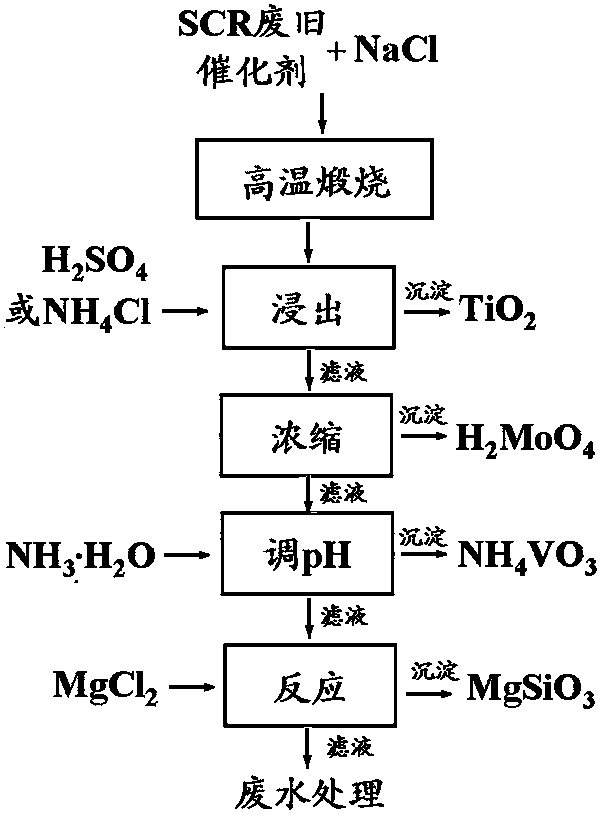Method for recovering Ti, V, Mo and Si in SCR (selective catalytic reduction) waste catalyst by combination of activation calcination and acid leaching
A waste catalyst and acid leaching technology, which is applied in the direction of silicate, magnesium silicate, process efficiency improvement, etc., can solve the problems of few reports on the recovery of flat-plate waste catalyst, large amount of acid usage, danger, etc., and shorten the acid The effect of processing time, reducing concentration and saving cost
- Summary
- Abstract
- Description
- Claims
- Application Information
AI Technical Summary
Problems solved by technology
Method used
Image
Examples
Embodiment 1
[0048] Such as figure 1 As shown, in this embodiment, a method for recovering Ti, V, Mo, and Si in spent SCR catalysts by activating calcination combined with acid leaching is carried out according to the following steps.
[0049] Raw material crushing: The honeycomb catalyst is directly crushed by a crusher to more than 100 mesh; the flat-plate catalyst is first crushed by a crusher, so that the active components of the catalyst are stripped from the steel mesh, and then the iron filings in the catalyst and the steel mesh are separated by two-stage magnetic separation technology .
[0050] Sodium roasting: Take the pulverized catalyst and mix it evenly with NaCl, the amount of NaCl is the mass of NaCl: catalyst mass = 0.2, put it into a rotary kiln and roast at a high temperature at 700 °C for 4 h at a constant temperature. Under high temperature conditions, the metal oxides in the catalyst react with NaCl to form the corresponding sodium salts.
[0051] Acidic leaching: Af...
Embodiment 2
[0059] Such as figure 1 As shown, in this embodiment, a method for recovering Ti, V, Mo, and Si in spent SCR catalysts by activating calcination combined with acid leaching is carried out according to the following steps.
[0060] Raw material crushing: The honeycomb catalyst is directly crushed by a crusher to more than 100 mesh; the flat-plate catalyst is first crushed by a crusher, so that the active components of the catalyst are stripped from the steel mesh, and then the iron filings in the catalyst and the steel mesh are separated by two-stage magnetic separation technology .
[0061] Sodium roasting: Take the pulverized catalyst and mix it evenly with NaCl, the amount of NaCl is the mass of NaCl: Catalyst mass = 0.2, put it into a rotary kiln and roast at a high temperature at 800 °C for 4 h at a constant temperature. Under high temperature conditions, the metal oxides in the catalyst react with NaCl to form the corresponding sodium salts.
[0062] Acid leaching: Afte...
Embodiment 3
[0070] Such as figure 1 As shown, in this embodiment, a method for recovering Ti, V, Mo, and Si in spent SCR catalysts by activating calcination combined with acid leaching is carried out according to the following steps.
[0071] Raw material crushing: The honeycomb catalyst is directly crushed by a crusher to more than 100 mesh; the flat-plate catalyst is first crushed by a crusher, so that the active components of the catalyst are stripped from the steel mesh, and then the iron filings in the catalyst and the steel mesh are separated by two-stage magnetic separation technology .
[0072] Sodium roasting: Take the pulverized catalyst and mix it evenly with NaCl, the amount of NaCl is the mass of NaCl: Catalyst mass = 0.2, put it into a rotary kiln and roast at a high temperature at 800 °C for 4 h at a constant temperature. Under high temperature conditions, the metal oxides in the catalyst react with NaCl to form the corresponding sodium salts.
[0073] Acid leaching: Afte...
PUM
 Login to View More
Login to View More Abstract
Description
Claims
Application Information
 Login to View More
Login to View More - R&D
- Intellectual Property
- Life Sciences
- Materials
- Tech Scout
- Unparalleled Data Quality
- Higher Quality Content
- 60% Fewer Hallucinations
Browse by: Latest US Patents, China's latest patents, Technical Efficacy Thesaurus, Application Domain, Technology Topic, Popular Technical Reports.
© 2025 PatSnap. All rights reserved.Legal|Privacy policy|Modern Slavery Act Transparency Statement|Sitemap|About US| Contact US: help@patsnap.com

